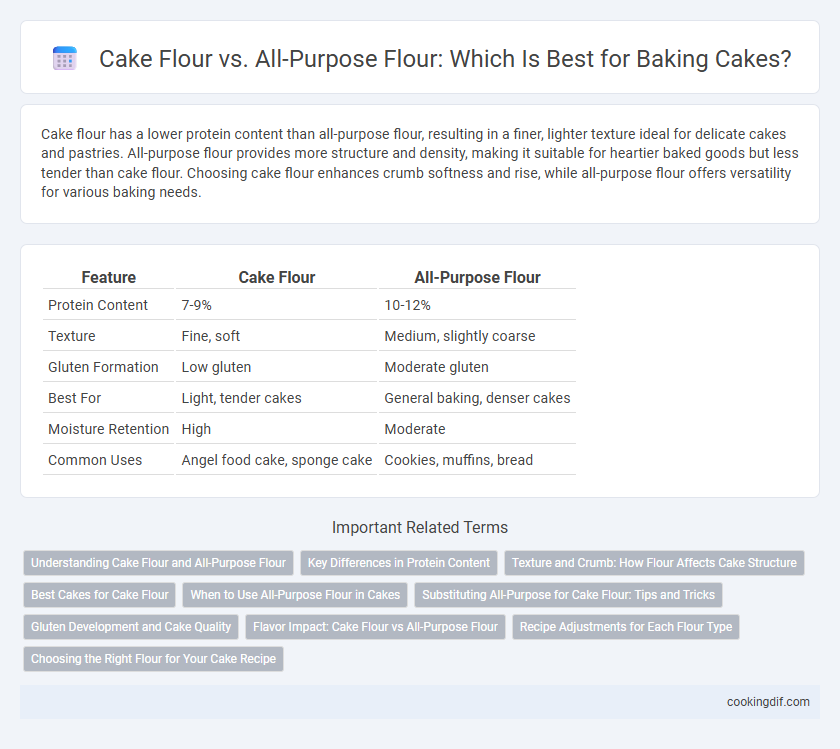Cake flour has a lower protein content than all-purpose flour, resulting in a finer, lighter texture ideal for delicate cakes and pastries. All-purpose flour provides more structure and density, making it suitable for heartier baked goods but less tender than cake flour. Choosing cake flour enhances crumb softness and rise, while all-purpose flour offers versatility for various baking needs.
Table of Comparison
| Feature | Cake Flour | All-Purpose Flour |
|---|---|---|
| Protein Content | 7-9% | 10-12% |
| Texture | Fine, soft | Medium, slightly coarse |
| Gluten Formation | Low gluten | Moderate gluten |
| Best For | Light, tender cakes | General baking, denser cakes |
| Moisture Retention | High | Moderate |
| Common Uses | Angel food cake, sponge cake | Cookies, muffins, bread |
Understanding Cake Flour and All-Purpose Flour
Cake flour contains a lower protein content, typically around 7-8%, which results in a finer, softer crumb ideal for delicate cakes and pastries. All-purpose flour has a higher protein level, around 10-12%, providing more gluten structure suitable for denser baked goods and general use. Choosing between cake flour and all-purpose flour directly impacts the texture and tenderness of the final cake product.
Key Differences in Protein Content
Cake flour contains approximately 7-9% protein, which is significantly lower than all-purpose flour's 10-12% protein content. The lower protein in cake flour results in less gluten formation, producing a tender, soft crumb ideal for delicate cakes. In contrast, all-purpose flour's higher protein provides more structure and chew, better suited for denser baked goods.
Texture and Crumb: How Flour Affects Cake Structure
Cake flour's lower protein content (typically 7-9%) produces a finer, softer crumb and tender texture by reducing gluten formation, ideal for delicate cakes like sponge or chiffon. All-purpose flour, with a higher protein level (10-12%), creates more gluten, resulting in a denser, chewier crumb and firmer structure better suited for heartier cakes like pound or carrot cake. Choosing cake flour ensures a lighter, fluffier cake texture, while all-purpose flour provides durability and structure, impacting overall cake mouthfeel and sliceability.
Best Cakes for Cake Flour
Cake flour's fine texture and lower protein content create lighter, softer cakes with delicate crumb structures, ideal for sponges, chiffon cakes, and angel food cakes. Its ability to absorb more liquid and sugar enhances moisture and tenderness, resulting in a more tender bite than all-purpose flour. Using cake flour is optimal for recipes requiring a finer crumb and less gluten development, producing superior texture and rise in classic layer and pound cakes.
When to Use All-Purpose Flour in Cakes
All-purpose flour is best used in cakes that require a denser, sturdier texture, such as pound cakes or layered cakes with rich fillings. Its moderate protein content provides enough gluten structure for cakes that need support without becoming overly tender. Choosing all-purpose flour enhances moisture retention and results in a cake with a slightly firmer crumb compared to cake flour.
Substituting All-Purpose for Cake Flour: Tips and Tricks
Substituting all-purpose flour for cake flour requires adjusting measurements to maintain cake texture, often by removing 2 tablespoons of all-purpose flour per cup and replacing with 2 tablespoons of cornstarch to mimic cake flour's lower protein content. Sifting the mixture multiple times ensures even distribution and a lighter crumb. This method helps achieve tender, soft cakes despite using a higher-protein flour type.
Gluten Development and Cake Quality
Cake flour contains lower protein content, typically around 7-8%, which limits gluten development, resulting in a tender and delicate crumb ideal for cakes. All-purpose flour, with a higher protein content of 10-12%, promotes more gluten formation, producing denser and chewier textures better suited for breads or pastries but less desirable in cakes. Choosing cake flour enhances cake quality by ensuring softness and fine crumb structure, while all-purpose flour may yield a firmer cake with less optimal texture.
Flavor Impact: Cake Flour vs All-Purpose Flour
Cake flour contains lower protein content, resulting in a tender crumb and subtle flavor that enhances delicate desserts. All-purpose flour has higher protein levels, producing a denser texture and more robust, wheaty flavor in cakes. Choosing cake flour yields lighter, softer cakes with a mild taste, while all-purpose flour creates richer flavor but firmer texture.
Recipe Adjustments for Each Flour Type
Cake flour has a lower protein content (6-8%) compared to all-purpose flour (10-12%), resulting in a lighter, more tender crumb ideal for delicate cakes. When substituting all-purpose flour for cake flour, reduce the flour amount by two tablespoons per cup and add two tablespoons of cornstarch to mimic the softer texture. Recipes using all-purpose flour may require slight adjustments in liquid content and mixing time to prevent toughness, whereas cake flour recipes benefit from minimal mixing to maintain fluffiness.
Choosing the Right Flour for Your Cake Recipe
Cake flour and all-purpose flour differ significantly in protein content, with cake flour containing about 7-8% protein, resulting in a softer, finer crumb ideal for delicate cakes like sponge and chiffon. All-purpose flour, with 10-12% protein, provides more structure and is better suited for denser cake types such as pound cakes or layered butter cakes. Selecting the right flour affects texture and rise; using cake flour yields a tender, airy texture, while all-purpose flour produces a firmer, chewier bite.
Cake Flour vs All-Purpose Flour for flour choice Infographic

 cookingdif.com
cookingdif.com